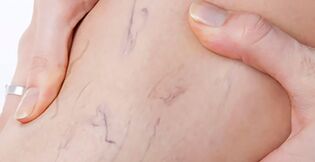
Small protruding veins aren't scary yet, but they should make you think!
The early stages of the disease are characterized by mild symptoms. However, a woman who cares about her health should not forget the first signs of the development of varicose veins:
- weight on the legs by the end of the day;
- swelling of the legs;
- pigmentation and thinning of the skin on the lower legs;
- limb numbness, frequent leg muscle cramps;
- protrusion of blood vessels above the skin surface;
- Appearance of vascular pattern, spider veins on legs.
If a woman returns home after a day's work and finds her feet in a "miserable condition, " you can't just blame the uncomfortable shoes or an extra "piece of salt" on the meal. Swelling and heaviness in the legs are the first signal of the development of blood stasis in the arteries. Remember - vascular disease is difficult to treat. Early prevention and timely medical care can stop or significantly slow down the process of varicose veins. Treatment should be started as soon as possible.
Varicose veins 1 degree
The main causes of varicose veins are pregnancy, overweight, prolonged physical activity, sedentary lifestyle, as well as a genetic predisposition to such a disease. Ordinary people called varicose veins "stewardess disease" due to the characteristics of this profession and their long standing. This degree of disease is the mildest.
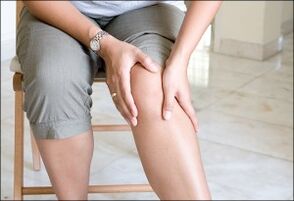
Classify the disease according to various factors. One of the classifications is according to the stages of development of the disease:
- Grade 1 varicose or compensatory stage.
- Grade 2 varicose veins or subcompensation stage.
- Grade 3 varicose veins or decompensation stage.
Different stages of varicose veins of the lower extremities have radically different treatments. You should not try to cope with the disease yourself. It can only do harm and lead to catastrophic consequences. It is better to seek help from a competent specialist.
The first degree of varicose veins is characterized by nocturnal swelling, nocturnal convulsive spasms. Often people confuse all these symptoms with ordinary fatigue. However, at this stage it is necessary to take preventive measures to improve the overall blood flow, including warming the feet, light foot massage, regular swimming, cycling.
Varicose veins of the first stage can also manifest as cramps in the calf area, and patients often complain of stretching of the legs or burning sensation in the muscles. This is increasingly accompanied by pain in the lower extremities.
Already at this stage, the manifestations of the visual nature of varicose veins are noticeable and should be alerted immediately:
- Mild cyanosis of the skin.
- The first spider veins appear in different parts of the body, mostly in the legs.
- The visible muscle of the veins.
Primary varicose veins are most often manifested by such external changes.
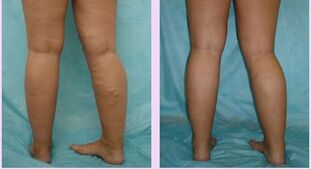
Another important factor in the manifestation of the first stage of varicose veins is the external conditions in which a person is. For example, in a hot environment, symptoms increase, swelling, pain and spasms increase.
Treatment of primary varicose veins
Sometimes doctors additionally recommend the use of venotonics, which are very effective in the treatment of varicose veins in the first stage. It is necessary to talk about massage separately: any therapy is not suitable for this disease. If the pain only intensifies after the procedure, then it is necessary to change the approach to the choice of a massage complex.
It is worth arranging soothing cool baths for the feet, which will relax the muscles, eliminate swelling, help reduce pain and relieve fatigue. However, hot baths should be excluded, as they do not improve the condition of the limbs with varicose veins.
Doctors can recommend the following treatments for this degree of varicose veins:
- Sclerotherapy - a special drug is injected directly into a vein. The effect of the drug is aimed at the resorption of blood vessels, strengthening the weak vascular walls, preventing blood flow in any area.
- Ozone therapy is an action aimed at strengthening blood vessels and resorption of varicose veins.
Each of the above options is very effective. However, the maximum effect can be achieved only when there are all the recommendations that need to be followed after using the procedures.
Wearing special compression garments is above all. Such an element helps to create pressure in the arteries and prevents it from expanding further.
Causes of the disease
There are more than fifty reasons that can cause a change in the venous system. Particularly susceptible to the disease are people whose profession is associated with stress and sedentary activities on their feet: salesmen, hairdressers, programmers, accountants, drivers.
Scientists have been researching for many years and have identified the main factors that cause varicose veins:
- Hormonal changes in the body: pregnancy, menopause, menopause;
- Any degree of obesity;
- Genetic predisposition. Varicose veins develop in 70% of children whose parents suffer from venous insufficiency;
- Weak muscular system;
- Wear uncomfortable clothes: tight elastic band socks, tight pants for men;
- Lack of activity and physical activity;
- The habit of sitting on one leg over the other;
- Rare changes in body position: standing for a long time, lying, sitting;
Chronic diseases: diabetes mellitus, high blood viscosity.
Eight out of ten patients with varicose veins are women. Poor sex leads to venous pathologies during pregnancy, postpartum, menopause due to forced hormonal disorders. The second important factor that women suffer from foot pain more than men is the love of high heels.
Rules and instructions
In the early stages of varicose veins, the patient is advised to follow the rules:
- Hike once or twice a day. To relax, you should stop from time to time and walk at a calm pace.
- Wear comfortable shoes with heels no higher than 3 cm. The upper part of the shoes should not have a pull device, the laces should not be tied as tightly as possible.
- Join the gym twice a week. Loads are selected individually by the doctor and trainer.
Review your diet. High-sugar, fatty meats, flour products and starchy vegetables are excluded. Most of the diet of a patient with varicose veins consists of steamed or boiled vegetables. Fried and spicy foods are not recommended.
- Legs need to rest in the evening. If you lift your legs and throw them on a high pillow or behind a sofa, blood flow will increase.
- If there is little movement at work, it is recommended to lubricate the feet with refreshing gels or ointments containing heparin.
- Special compression garments or elastic bandages are used every day. Special underwear is selected by the doctor. The feature of compression garments is the compression function. The pressure on the body occurs with a changing force, forcing the blood to circulate.
- Change position frequently. If you have to sit constantly at work, get up and sit down several times every 30 minutes. Exercise will help prevent varicose veins and hemorrhoids in the legs.
Treatment of different stages
A therapy that is effective in the early stages may have side effects in advanced pathology. The choice of treatment methods should be appropriate to the stages of varicose veins:
Compression form
It is used at all stages of varicose veins, but the degree of compression should vary significantly at different stages of disease development. In the early stages of varicose veins, compression is used for prophylactic purposes during standing and sedentary work.
Compression can stop the development of varicose veins, but it is necessary to consult a venologist before medical use, because compression is dangerous by aggravating the problem of varicose veins. In the stages of compensation and subcompensation with edema and noticeable varicose veins are usually prescribed underwear of the first and second compression classes.
The third compression class is used in cases of severe venous insufficiency. If lymphatic edema occurs, use fourth-grade underwear. The hospital uniform is used for inpatient treatment.
Folk remedies
Traditional medicine helps to treat varicose veins in the early stages. The following tools are widely used:
- Apply cabbage leaves
- potato, wormwood and garlic compressors;
- chestnut tinctures,
- hops and nettles.
However, folk remedies are combined with ease of use, accessibility, softness of action, low effectiveness (compared to drugs), so the enthusiasm for these methods is fraught with the development of the disease. Herbal medicines and compresses should be used after medical advice and should only serve as an adjunct to basic treatment.
Hirudotherapy
Leech treatment is rarely indicated in the advanced stages of varicose veins. Leech is sometimes prescribed for thrombophlebitis.
Leeches can cause allergies and trophic ulcers that aggravate varicose veins. Currently, the method is being replaced by non-traumatic drugs with anticoagulant components.
Medications
Medications can help relieve symptoms. Grapes, chestnuts, tablets, capsules, which are biologically active ingredients, are effective in the early stages of varicose veins.
Assistance is awarded during the compensation phase. Most ointments and gels contain heparin, which prevents blood clots. The effect of ointments and gels is largely due to massage during application.
However, the use of such products in the stage of decompensation can lead to additional skin manifestations. Drug relief is often temporary and does not cure the underlying cause.
Operations
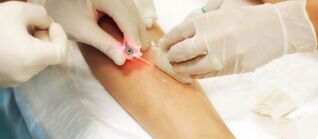
Laser coagulation and sclerotherapy are minimally invasive methods to remove blood vessels from the bloodstream. It is used for small diameters of dilated veins in the early stages of varicose veins (when getting rid of spider veins, nets).
Endovasal laser coagulation of varicose veins
Phlebectomy
Surgical removal of blood vessels is accompanied by trophic ulcers and complications in the third stage of the disease. In some cases, varicose veins in the legs do not develop according to the model presented in the phased classification. For example, the symptoms of the first stage may be completely absent: immediately a picture of subcompensation appears.
Otherwise, as the disease progresses, some varicose veins do not add to the symptoms of the previous stage and disappear. Therefore, in the early 21st century, Russian phlebologists, in addition to a step-by-step approach, adopted the International Classification (CEAP), which takes into account the individual characteristics of the course of varicose veins and the effects of treatment when diagnosing the severity of the disease.
symptoms
The pathological symptoms of varicose veins do not make people think about venous diseases:
- feeling of heaviness in the legs;
- fatigue after walking.
They are associated with flat feet, unusual high-heeled shoes, uncomfortable new shoes, and osteochondrosis of the spine.
And only the visual detection of cyanotic dilated veins under the skin raises the suspicion of the development of varicose veins.
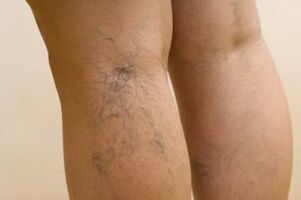
As the first sign of varicose veins, vascular meshes are most often seen below the knees
Women see a doctor when they see unpleasant cosmetic defects in the form of red venous "spiders" on the skin of the legs, under the knees and thighs.
The "influx" of young women who consult a phlebologist specializing in venous diseases is generally associated with the summer beach season, rather than looking healthier. They want to restore the beauty of the skin of the feet with the help of pills.
Pregnant women pay more attention to their situation. In addition to cosmetic changes, they report difficulty walking and increased fatigue in the evening.
The initial stage of the disease is characterized by the disappearance of clinical symptoms after prolongation.
You can prove yourself by doing this experiment: measure the volume of the lower leg at the level of the ankle or calf muscles in the morning and evening after work. If the difference is more than 1 cm, there are signs of primary varicose veins.
Appears later:
- leg pain;
- swelling of the legs;
- feeling of fullness and heaviness in the legs;
- nocturnal muscle cramps;
- Dilated veins are like tight "snake" cords with dark areas of skin.
These symptoms are undoubtedly manifestations of venous insufficiency and require treatment.
The main causes of varicose veins in women
Fatigue and edema may be the first manifestations of venous blood flow disorders
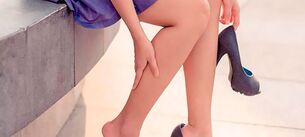
The sex hormone estrogen plays a special role in the development of varicose veins in women. Exercise causes problems such as weight gain, depression, edema, drowsiness, dry mucous membranes. This hormone increases the permeability of small blood vessels. The fluid leaves the bloodstream easily, making the blood flow less. Excess fluid accumulates in the surrounding tissues. These factors contribute to the development of stagnation in the arteries of the lower extremities.
Causes of estrogen increase in women:
- Imbalance in estrogen-progesterone production. Occurs as a result of a decrease in progesterone levels in a woman's body;
- Chronic stress. During stress, the body produces cortisol, which inhibits the synthesis of progesterone;
- Pregnancy. During pregnancy, the amount of estrogen in a woman's body increases;
- Contraception. Varicose veins occur as a side effect of taking these medications;
- Liver disease due to the elimination of estrogen from the body by the liver. With poor function, this hormone accumulates in the body;
- Age-related changes in hormonal levels also lead to an imbalance of sex hormones with the predominance of estrogen.
Separately, it should be noted that the reasons for the development of varicose veins are overweight and genetic predisposition to this disease. Genetic predisposition cannot be prevented if overweight can be fought for health in general. As a result of these factors, varicose veins have significantly "rejuvenated" and are now more common in girls aged 16-20.
Full liver function is important to maintain normal hormone levels. In addition to eliminating excess hormones, it is involved in the synthesis of substances - the precursors of progesterone and estrogen. Improving performance requires physical activity, good nutrition, and minimizing the body's intake of toxins.
Treatment of varicose veins with traditional medicine
Drug treatment of varicose veins in the legs is the most effective method, suitable for almost all patients. A wide range of drugs allows you to choose a drug that is more suitable for long-term treatment.
Medicines for the treatment of varicose veins of the legs
Venotonics is one of the most effective drugs for the treatment of this disease. Venotonics are drugs that increase vascular tone and improve blood flow through the arteries.
These tablets can prevent the formation of characteristic varicose veins and nodules.
Apply ointment
The best treatment for varicose veins of the legs is an integrated approach that includes the use of drugs in tablet form, gels and ointments for external treatment of problem areas.
Ointment for varicose veins in the legs also improves blood flow and prevents clotting.
These products are recommended for use only after consultation with a physician who will determine the duration of treatment and regimen.
Do not self-medicate - it can do more harm than good to the patient.
Consequences of varicose veins.
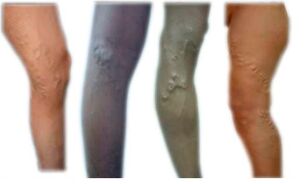
Varicose veins can cause trophic leg ulcers, thrombosis of the varicose vascular system, thrombophlebitis, pulmonary embolism (sudden death) to appear completely healthy.
The complex stages of varicose veins require surgery. Although women suffer the most from varicose veins, men are also affected by the disease, mainly due to hereditary causes.
A man under the age of 40 may appear on the operating table, and radical measures are used to treat him with varicose veins - the diseased veins are removed.
Varicose veins are easy to remove.
The surgeon makes an incision in the groin area, where a large sapenous vein affected by varicose veins flows into the femoral vein. The vein is exposed, closed and cut, and a second incision is made in the ankle. With the help of a special metal probe, which enters the lumen of the vessel, the entire dilated vessel is removed.
There will be no relapse in the future with the right operating technology. The blood supply to the leg is distributed to other vessels, and after 2 weeks everything is completely restored.
Risk factors for the development of varicose veins.
- Connective tissue genetics and pathology;
- woman;
- Hormonal medications: progesterone, estrogen;
- Pregnancy;
- Age: more common after age 50;
- Overweight and physical inactivity;
- Standing in an upright position for a long time (foot work: hairdressers, vendors, teachers, etc. );
- Obesity.
Symptoms and signs of varicose veins and chronic venous insufficiency.
| Symptoms of varicose veins | External signs |
| Painful aches | Telangiectasia |
| Heavy legs | Reticular vessels |
| Fatigue | Varicose Veins |
| Swelling | Thrombophlebitis |
| Itchy skin | Hyperpigmentation |
| Foot discomfort | Bleeding from the trauma node |
| Cramps in calf muscles | Ulceration |
Varicose vein treatment options.
The choice of treatment depends on the diameter and type of varicose veins
- Varicose veins of saphenous veins
- Drug treatment
- Elastic compression and bandaging of the legs
- Injection sclerotherapy
- Foam sclerotherapy
- Laser therapy
- Miniflebectomy
Dear women, varicose veins can wrap you in long skirts and pants forever. If pills and ointments can't get your feet back to normal, the only sure way to get rid of varicose veins is to leave. In what way and where, only after consultation with a specialist phlebologist. Excess veins can be treated with high precision surgery, without hospitalization, without anesthesia, without incisions. You just have to be more discriminating with the help you render toward other people.
Learn more about varicose veins, symptoms, disease prevention, special exercises, treatment methods and proper nutrition ovaricose. ru website.
How varicose veins appear in the early stages. Why is it dangerous
As a rule, reticular varicose veins are painless. Therefore, the most common complaints of patients to doctors are cosmetic defects - visible reticular veins.
More rarely, the appearance of such a varicose mesh is accompanied by a burning sensation or other changes in skin sensitivity.
In addition to these symptoms, the first stage of varicose veins manifests itself:
- weight on legs;
- increased leg fatigue;
- cramps in the muscles of the lower extremities, especially at night;
- itching at the site of appearance of the vascular network;
- swelling of the feet and legs.
Treatment should be started in time to prevent the development of the disease
Therefore, it is important to consult a phlebologist, angiologist or vascular surgeon, who will tell you in time what to do with such skin formations. To get started, a specialist will perform an examination and help determine the causes of the formation of stars or mesh, as well as prescribe the necessary additional tests to help determine the degree of venous circulatory disorders
To determine the degree of vascular lesions and their deficiency:
- complete blood count (indicates whether the patient has anemia or thrombocytopenia);
- biochemical blood test (detects blood clotting disorders or liver and kidney function);
- general urinalysis (detects kidney problems);
- vascular ultrasound examination - duplex angiocanalization (detects pathology of the vascular wall and blood flow disorders);
- Contrast X-ray phlebography (determines the location of venous lesions and the degree of dysfunction).
If you do nothing after detecting the first signs of reticular varicose veins, it is possible:
- inflammation and development of thrombophlebitis of the superficial vessels of the lower extremities;
- the transition of the pathological process from the superficial vessels of the lower extremities to the deep ones;
- venous thrombosis. If thrombosis occurs in the venous vessels of the head, it is dangerous for stroke and sinus thrombosis;
- Thromboembolism of the pulmonary arteries is a fatal complication caused by the separation of the thrombus from the vessel wall and the obstruction of the lumen of the pulmonary arteries.
If you ignore the appearance of reticular varicose veins and do not start treatment on time, the disease will develop. Then the development of complications will be inevitable.
Prevention
Don't forget about preventive measures. You need to spend time in sports to prevent it.
Avoid excessive physical exertion. Wear comfortable shoes with low (up to 4 cm) heels. Remember that hot baths, baths and saunas have a negative impact on the health of the legs.
And following these simple guidelines will help prevent the development of this disease:
- Try to get rid of bad habits - alcohol consumption and smoking have a negative effect on the condition of your arteries;
- compression therapy - wear medical socks, pantyhose and knee pads;
- diet, weight control (overweight people are more likely to suffer from varicose veins), exclude fatty meats and poultry, avoid spicy and salty foods, be sure to include vegetables and fruits in the diet;
- Massage - Get in the habit of doing a light foot massage after a hard work, it will help to relax and improve the body's natural blood circulation.
Preventing any disease is always easier than treating it. Bless you!













































